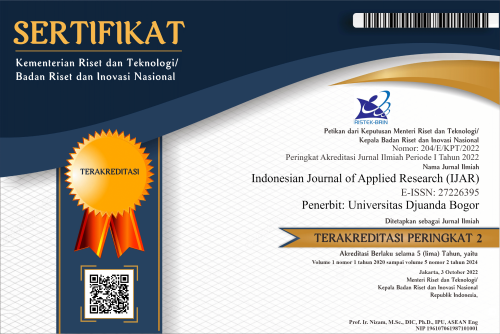Isolation and Anti-Yeast Activity of Secondary Metabolites of Soursop Leaf Endophytic Fungi
Abstract
This study aimed to isolate the endophytic fungi of soursop leaves that have the potential as anti-yeast. Soursop leaves were collected from 3 locations in West Java, Indonesia. The secondary metabolites produced by the endophytic fungi were extracted with ethyl acetate and tested for anti-yeast activity against Saccharomyces cerevisiae and Candida tropicalis. Profile of extracts contents characterization was carried out by using thin-layer chromatography (TLC). Twelve monoculture soursop leaves endophytic fungi isolates from Sukabumi (3 isolates), Cianjur (3 isolates), and Garut (6 isolates). It showed different abilities to inhibit C. tropicalis and S. cereviseae. The best extract is isolat from Cianjur (Sir-C1) and Sukabumi (Sir-S1). The stain patterns seen between the nine endophytic fungi extracts were similar. This indicates that the compounds in them may also be the same. But the extracts have a different absorbance for anti-yeast activities. This indicates that the total metabolites of each isolate are different. TLC results showed that ethyl acetate extraction produced almost the same metabolite components from nine endophytic fungi extracts, and all extracts had an anti-yeast activity with various absorbance. There are differences in the ability of 12 soursop leaf endophytic fungi to inhibit yeast model C. tropicalis and S. cerevisiae. Some extracts have similar TLC profiles, but their anti-yeast activity is not similar
References
Adri, D., & Hersoelistyorini, W. (2013). Aktivitas Antioksidan dan Sifat Organoleptik Teh Daun Sirsak ( Annona muricata Linn . ) Berdasarkan Variasi Lama Pengeringan Antioxidant Activity and Organoleptic Charecteristic of Soursop ( Annona muricata Linn .) Leaf Tea Based on Variants Time Drying. Jurnal Pangan Dan Gizi, 04(07).
Agusta, A. (2013). Nerolidol, Komponen Kimia Aromatik Tanaman Teh Yang Juga Diproduksi Oleh Jamur Endofit Schizophyllum SP. D [Nerolidol, an Aromatic Chemical Constituent of Tea Plant That Produces by an Endophytic Fungi Schizophyllum SP. D]. Berita Biologi, 12(2).
Arifni, F. R., Hasan, A. E. Z., Hasim, Julistiono, H., Husnawaty, Bermawie, N., & Riyanti, E. I. (2017). Anti-cancer activities of endophytic fungi isolated from soursop leaves (Annona muricata L.) against WiDr cancer cells. Annual Research and Review in Biology, 18(5), 1–11. https://doi.org/10.9734/ARRB/2017/34657
Audu, S. S., Aremu, M. O., Beetseh, C., Haruna, G. S., & Adoga, J. (2019). Phytochemical screening, antioxidant activity, and mineral composition of soursop (Annona muricata) pulp, peel, and seed. FUW Trends in Science & Technology Journal, 4(2), 501–505. https://doi.org/10.13140/RG.2.2.28043.03367
Backer, R., Rokem, J. S., Ilangumaran, G., Lamont, J., Praslickova, D., Ricci, E., Subramanian, S., & Smith, D. L. (2018). Plant Growth-Promoting Rhizobacteria: Context, Mechanisms of Action, and Roadmap to Commercialization of Biostimulants for Sustainable Agriculture. Frontiers in Plant Science, 9. https://doi.org/10.3389/fpls.2018.01473
Engel, S. R., Dietrich, F. S., Fisk, D. G., Binkley, G., Balakrishnan, R., Costanzo, M. C., Dwight, S. S., Hitz, B. C., Karra, K., Nash, R. S., Weng, S., Wong, E. D., Lloyd, P., Skrzypek, M. S., Miyasato, S. R., Simison, M., & Cherry, J. M. (2014). The Reference Genome Sequence of Saccharomyces cerevisiae: Then and Now. G3: Genes, Genomes, Genetics, 4(3), 389–398. https://doi.org/10.1534/g3.113.008995
Enweani, I. B., Obroku, J., Enahoro, T., & Omoifo, C. (2004). The biochemical analysis of soursop ( Annona muricata L .) and sweetsop ( A . squamosa L .) and their potential use as oral rehydration therapy. Food, Agriculture & Environment, 2(1), 39–43.
Gajalakshmi, S., Vijayalakshmi, S., & Devi Rajeswari, V. (2012). Phytochemical and pharmacological properties of Annona muricata: A review. International Journal of Pharmacy and Pharmaceutical Sciences, 4(2), 3–6.
Hasan, A. E. Z., Bermawie, N., Julistiono, H., Riyanti, E. I., Hasim, H., & Suhendar, U. (2020). Phytochemical screening and anti-breast cancer activities of Annona muricata (L.) leaf extracts. Pharmacologyonline, 2, 23–30.
Lukisari, C., & Harijanti, K. (2010). Penatalaksanaan infeksi Candida tropicalis pada penderita median rhomboid glossitis. Dentofasial, 10(1), 13–18.
Marag, P. S., & Suman, A. (2018). Growth stage and tissue-specific colonization of endophytic bacteria having plant growth-promoting traits in hybrid and composite maize (Zea mays L.). Microbiological Research, 214, 101–113. https://doi.org/10.1016/j.micres.2018.05.016
Minarni, Artika, I. M., Julistiono, H., Bermawie, N., Riyanti, E. I., Hasim, & Hasan, A. E. Z. (2017). Anti-cancer activity test of ethyl acetate extract of endophytic fungi isolated from soursop leaf (Annona muricata L.). Asian Pacific Journal of Tropical Medicine, 10(6), 566–571. https://doi.org/10.1016/j.apjtm.2017.06.004
Moghadamtousi, Soheil Z., Kadir, H. A., Paydar, M., Rouhollahi, E., & Karimian, H. (2014). Annona muricata leaves induced apoptosis in A549 cells through mitochondrial-mediated pathway and involvement of NF-κB. BMC Complementary and Alternative Medicine, 14(1), 1–13. https://doi.org/10.1186/1472-6882-14-299
Moghadamtousi, Soheil Zorofchian, Rouhollahi, E., Karimian, H., Fadaeinasab, M., Firoozinia, M., Abdulla, M. A., & Kadir, H. A. (2015). The chemopotential effect of Annona muricata leaves against azoxymethane-induced colonic aberrant crypt foci in rats and the apoptotic effect of acetogenin annomuricin e in HT-29 cells: A bioassay-guided approach. PLoS ONE, 10(4), 1–28. https://doi.org/10.1371/journal.pone.0122288
Ni Putu Rahayu Artini, Sri Wahjuni, dan W. D. S. (2012). Ekstrak Daun Sirsak (Annona Muricata L.) Sebagai Antioksidan Pada Penurunan Kadar Asam Urat Tikus Wistar. Jurnal Kimia, 6(2), 127–137. https://doi.org/10.1053/j.seminoncol.2004.07.017
Nurrochmat, D. R., Nugroho, I. A., Hardjanto, Purwadianto, A., Maryudi, A., & Erbaugh, J. T. (2017). Shifting contestation into cooperation: Strategy to incorporate different interests of actors in medicinal plants in Meru Betiri National Park, Indonesia. Forest Policy and Economics, 83(January 2015), 162–168. https://doi.org/10.1016/j.forpol.2017.08.005
Paarakh, P., Chansouria, J., & Khosa, R. (2009). Wound healing activity of Annona muricata extract. Journal of Pharmacy Research, 2(3), 404–406. http://herbs.ph/attachments/article/675/Wound healing activity of Annona muricata extract.pdf
Parris, N. A. (1976). Chapter 6 Nature of the mobile phase. In N. A. Parris (Ed.), Instrumental Liquid Chromatography (Vol. 5, pp. 95–126). Elsevier. https://doi.org/https://doi.org/10.1016/S0301-4770(08)61247-6
Polak, B., & Pajurek, E. (2021). Separation of some vitamins in reversed-phase thin-layer chromatography and pressurized planar electrochromatography with eluent containing surfactant. Scientific Reports, 11(1), 1–14. https://doi.org/10.1038/s41598-021-01323-1
Ruta, L. L., Popa, C. V., & Farcasanu, I. C. (2020). Cytotoxicity of Oleandrin Is Mediated by Calcium Influx and by Increased Manganese Uptake in Saccharomyces cerevisiae Cells. Molecules, 25(18), 17–19. https://doi.org/10.3390/molecules25184259
Setyowati, Francisca Murti, W. (2007). Diversity of medicinal plant by Talang Mamak tribe in surrounding of Bukit Tiga Puluh National Park, Riau. Biodiversitas Journal of Biological Diversity, 8(3), 228–232. https://doi.org/10.13057/biodiv/d080313
Solomon-Wisdom. (2014). Phytochemical Screening and Antimicrobial activities of Annona muricata ( L ) leaf extract.
Strobel, G., & Daisy, B. (2003). Bioprospecting for microbial endophytes and their natural products. Microbiology and Molecular Biology Reviews : MMBR, 67(4), 491–502. https://doi.org/10.1128/MMBR.67.4.491-502.2003
Tan, R.-X., & Zou, W. X. (2001). Endophytes: a rich source of functional metabolites. Natural Product Reports, 18 4, 448–459.
Copyright (c) 2022 Indonesian Journal of Applied Research (IJAR)

This work is licensed under a Creative Commons Attribution-ShareAlike 4.0 International License.
The Authors submitting a manuscript do so on the understanding that if accepted for publication, copyright publishing of the article shall be assigned/transferred to Indonesian Journal of Applied Research (IJAR) Universitas Djuanda as Publisher of the journal. Upon acceptance of an article, authors will be asked to complete a 'Copyright Transfer Agreement'. An e-mail will be sent to the corresponding author confirming receipt of the manuscript together with a 'Copyright Transfer Agreement' form by online version of this agreement.
Indonesian Journal of Applied Research (IJAR) Universitas Djuanda, the Editors and the Editorial Board make every effort to ensure that no wrong or misleading data, opinions or statements be published in the journal. In any way, the contents of the articles and advertisements published in the Indonesian Journal of Applied Research (IJAR) Universitas Djuanda are sole and exclusive responsibility of their respective authors and advertisers.
Remember, even though we ask for a transfer of copyright, our journal authors retain (or are granted back) significant scholarly rights as mention before.
The Copyright Transfer Agreement (CTA) Form can be downloaded here: Copyright Transfer Agreement-IJAR 2020
The copyright form should be signed electronically and send to the Editorial Office e-mail below:
Prof. Dr. Ir. Dede Kardaya, M.Si. (Editor-in-Chief)
Universitas Djuanda
Jl. Tol Jagorawi No.1, Ciawi, Kec. Ciawi, Bogor, Jawa Barat 16720
Website: http://journal.unida.ac.id/index.php/IJAR/index
Email: ijar@unida.ac.id






 This work is licensed under a
This work is licensed under a 